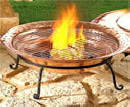|
|
When the sun goes down, cozy up to outdoor fireplaces and patio
heaters that warm your outdoor living space
Outdoor fireplaces and
patio heaters are not new ideas; restaurants have been using them for years and
many a backyard has boasted a dugout fire pit lined with bricks or stones.
 Today,
outdoor fireplaces and patio heaters are popular deck design upgrades, mostly
because of the affordable price tag and wide variety of styles. They extend
the use of your deck or patio by casting a 3-
to 20-foot circle of warmth around you and your guests. You stay comfortable in
the early spring, fall, and of course evening when temperatures are cooler. Today,
outdoor fireplaces and patio heaters are popular deck design upgrades, mostly
because of the affordable price tag and wide variety of styles. They extend
the use of your deck or patio by casting a 3-
to 20-foot circle of warmth around you and your guests. You stay comfortable in
the early spring, fall, and of course evening when temperatures are cooler.
Types of patio heaters and outdoor fireplaces
Here's a quick overview of the types of patio heaters and outdoor fireplaces
available:
-
Patio heaters: these are free standing and tabletop heaters fueled by
natural gas or propane. The lighting mechanism is automatic and the
emergency off switches are automatic should the unit be tipped over or bumped.
-
Infrared patio heaters: these are wall or pole mounted units fueled by
natural gas or electricity that emit infrared heat.
-
Outdoor fireplaces: these are free standing enclosed units with chimneys
that vent the smoke and ash, and generally fueled by wood or briquettes. There are propane and natural gas models that have the look of a wood
burning fireplace without the smoke.
-
Fire pits: these are the traditional campfire jazzed up using decorative
copper, and cast iron.
-
Chimineas: these are Mexican-style outdoor fireplaces featuring a chubby
base where the fire burns, and a tall narrow chimney to vent the smoke.
Traditional chimineas are made from fired clay, but cast iron models are also
available.
-
Fire rings: these are the most inexpensive and simplistic style of outdoor
fireplace. Like the fire pits at campsites and cottages, the cast iron ring is
bottomless and it simply contains the fire within a safe burning site.
There are also some other unique products that are either a
combination-type outdoor fireplace or stand alone.
-
California Redwood Outdoor Portable Fire Pit:
has an attractive redwood surround and comes with custom fire log grate made
from welded iron bar, a retractable stainless steel spark screen, and high
quality, custom vinyl weather cover for when the fire pit is not in use.
-
Luminarium Outdoor Hearth: uses fermentation grade ethyl alcohol
(ethanol) as a fuel source. Unlike natural gas or propane, this fuel (a gel
actually), causes random, dancing, crackling flames. So, you get the look and
feel of a wood fire without the smoke, embers or ash. The cost starts at around
$500 for the unit. Fuel packs are around $35 and each pack burns approximately
three hours.
Tips for understanding fuel sources
If you're just beginning your research into purchasing a patio heater or
outdoor fireplace, think about the best fuel source for your needs. Efficiency,
cost to operate, and safety are a few of the factors to consider.
Natural gas, propane, solid fuel, and electricity are the most common fuel
sources for outdoor heating.
-
Natural gas: the cleanest burning of all the fossil fuels and considered to
be quite safe. It will only burn if it is in concentration of 4 to 15%
per volume of air and can only ignite at a very high temperature (1100 degrees
Fahrenheit), which makes accidental ignition or combustion unlikely. It is ideal for permanent
installations of outdoor heating and grilling appliances because natural gas
lines must be run by a certified gas fitter.
-
Propane: an odorless gas that is intentionally given the smell of rotten eggs
to alert you when propane is present. Unlike natural gas, propane is heavier
than air so it collects at the bottom of storage containers if leaked. It can
also ignite easily if near a heat source. It is convenient because it is readily
available as a bottled fuel that can be
attached to a patio heater or fireplace and moved around easily.
-
Solid fuel (wood, charcoal, briquettes, pressed logs): these are the
traditional fuels for campfires, fire pits and fireplaces. While the heat from
these sources is quite often the best, safety can be a concern especially if the
household has small children. Obviously, solid fuel fires can not be turned on
and off with the flick of a switch.
-
Electricity (infrared): another safe way of heating outdoor spaces.
Infrared heat works by...
Compare outdoor fireplaces and patio heaters
Here is a general comparison of the types of outdoor fireplaces and patio
heaters.
| Type |
Fuel |
Characteristics |
Cost (approx.) |
| patio heater |
Natural gas
Propane |
-freestanding and tabletop
-stainless steel |
$250-$1200 |
| outdoor fireplace |
Wood
Charcoal
Briquettes |
-enclosed fire
-chimney vents smoke, ash and embers |
$400-$550 |
| outdoor fire pit |
Wood
Charcoal
Briquettes |
-not enclosed, open fire (but may have spark
screen)
-can be used as a BBQ
-made from copper, steel, cast iron |
$150-$300 |
| portable fire pit |
Wood
Charcoal
Briquettes |
-same as the outdoor fire pit but mounted on wheels
-can be moved in and out of storage easily |
$100-$300 |
| chimenea |
Wood
Charcoal
Briquettes |
-classic Mexican outdoor fireplace
-pot-belly style
-made of fired clay, copper or cast iron |
$250-$300 |
| fire ring |
Wood
Charcoal
Briquettes |
-bottomless cast iron ring that contains fire |
$100 |
| overhead infrared patio heater |
Natural gas
Electric |
-mounts to a wall, pole or overhead |
$1000-2000 |
More Articles...
|
|